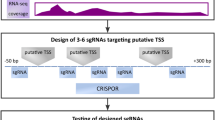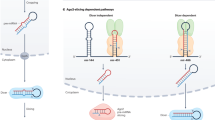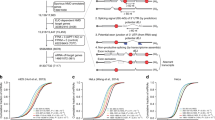Abstract
Micro(mi)RNAs are small noncoding RNAs that regulate expression of the majority of the genes in the genome at either the messenger RNA (mRNA) level (by degrading mRNA) or the protein level (by blocking translation). miRNAs are thought to be components of vast regulatory networks. Currently, the field is focused primarily on identifying novel targets of individual miRNAs. This focus is about to undergo a dramatic change. In a new paper by Wu et al. (2010) it is experimentally confirmed that multiple miRNAs target the same gene, suggesting that it is the combination of all these activities that determines the expression of miRNA target genes. This study ushers in a new era of miRNA research that focuses on networks more than on individual connections between miRNA and strongly predicted targets.
This is a preview of subscription content, access via your institution
Access options
Subscribe to this journal
Receive 50 print issues and online access
$259.00 per year
only $5.18 per issue
Buy this article
- Purchase on Springer Link
- Instant access to full article PDF
Prices may be subject to local taxes which are calculated during checkout

Similar content being viewed by others
References
Baek D, Villen J, Shin C, Camargo FD, Gygi SP, Bartel DP . (2008). The impact of microRNAs on protein output. Nature 455: 64–71.
Chi SW, Zang JB, Mele A, Darnell RB . (2009). Argonaute HITS-CLIP decodes microRNA-mRNA interaction maps. Nature 460: 479–486.
Forman JJ, Legesse-Miller A, Coller HA . (2008). A search for conserved sequences in coding regions reveals that the let-7 microRNA targets Dicer within its coding sequence. Proc Natl Acad Sci USA 105: 14879–14884.
Friedman RC, Farh KK, Burge CB, Bartel DP . (2009). Most mammalian mRNAs are conserved targets of microRNAs. Genome Res 19: 92–105.
Grimson A, Farh KK, Johnston WK, Garrett-Engele P, Lim LP, Bartel DP . (2007). MicroRNA targeting specificity in mammals: determinants beyond seed pairing. Mol Cell 27: 91–105.
Hammell M, Long D, Zhang L, Lee A, Carmack CS, Han M et al. (2008). mirWIP: microRNA target prediction based on microRNA-containing ribonucleoprotein-enriched transcripts. Nat Methods 5: 813–819.
Hobert O . (2007). miRNAs play a tune. Cell 131: 22–24.
Ivanovska I, Ball AS, Diaz RL, Magnus JF, Kibukawa M, Schelter JM et al. (2008). MicroRNAs in the miR-106b family regulate p21/CDKN1A and promote cell cycle progression. Mol Cell Biol 28: 2167–2174.
Jiang Q, Feng MG, Mo YY . (2009). Systematic validation of predicted microRNAs for cyclin D1. BMC Cancer 9: 194.
Johnson SM, Grosshans H, Shingara J, Byrom M, Jarvis R, Cheng A et al. (2005). RAS is regulated by the let-7 microRNA family. Cell 120: 635–647.
Khan AA, Betel D, Miller ML, Sander C, Leslie CS, Marks DS . (2009). Transfection of small RNAs globally perturbs gene regulation by endogenous microRNAs. Nat Biotechnol 27: 549–555.
Krek A, Grun D, Poy MN, Wolf R, Rosenberg L, Epstein EJ et al. (2005). Combinatorial microRNA target predictions. Nat Genet 37: 495–500.
Kumar MS, Lu J, Mercer KL, Golub TR, Jacks T . (2007). Impaired microRNA processing enhances cellular transformation and tumorigenesis. Nat Genet 39: 673–677.
Lewis BP, Burge CB, Bartel DP . (2005). Conserved seed pairing, often flanked by adenosines, indicates that thousands of human genes are microRNA targets. Cell 120: 15–20.
Liu G, Min H, Yue S, Chen CZ . (2008). Pre-miRNA loop nucleotides control the distinct activities of mir-181a-1 and mir-181c in early T cell development. PLoS ONE 3: e3592.
Orom UA, Nielsen FC, Lund AH . (2008). MicroRNA-10a binds the 5′UTR of ribosomal protein mRNAs and enhances their translation. Mol Cell 30: 460–471.
Petrocca F, Visone R, Onelli MR, Shah MH, Nicoloso MS, de Martino I et al. (2008). E2F1-regulated microRNAs impair TGFbeta-dependent cell-cycle arrest and apoptosis in gastric cancer. Cancer Cell 13: 272–286.
Rajewsky N . (2006). microRNA target predictions in animals. Nat Genet 38 (Suppl): S8–S13.
Ritchie W, Flamant S, Rasko JE . (2009). Predicting microRNA targets and functions: traps for the unwary. Nat Methods 6: 397–398.
Schickel R, Boyerinas B, Park SM, Peter ME . (2008). MicroRNAs: key players in the immune system, differentiation, tumorigenesis and cell death. Oncogene 27: 5959–5974.
Tay Y, Zhang J, Thomson AM, Lim B, Rigoutsos I . (2008). MicroRNAs to Nanog, Oct4 and Sox2 coding regions modulate embryonic stem cell differentiation. Nature 455: 1124–1128.
Watanabe Y, Tomita M, Kanai A . (2007). Computational methods for microRNA target prediction. Methods Enzymol 427: 65–86.
Wu S, Huang S, Ding J, Zhao Y, Liang L, Liu T et al. (2010). Multiple microRNAs modulate p21 Cip1/Waf1 expression by directly targeting its 3′ untranslated region. Oncogene (this issue).
Author information
Authors and Affiliations
Corresponding author
Ethics declarations
Competing interests
The author declares no conflict of interest.
Rights and permissions
This article is cited by
-
Psychosocial Stress and MicroRNA Expression Profiles in Myometrial Tissue of Women Undergoing Surgical Treatment for Uterine Fibroids
Reproductive Sciences (2024)
-
Erythrocyte miRNA-92a-3p interactions with PfEMP1 as determinants of clinical malaria
Functional & Integrative Genomics (2023)
-
miRNA Regulatory Networks Underlying the Root–Leaf Synergism in Salt Tolerant Pokkali Rice
Journal of Plant Growth Regulation (2023)
-
Discerning the Prospects of miRNAs as a Multi-Target Therapeutic and Diagnostic for Alzheimer’s Disease
Molecular Neurobiology (2023)
-
Expression Signature of Immune-Related MicroRNAs in Autoimmune Skin Disease: Psoriasis and Vitiligo Insights
Molecular Diagnosis & Therapy (2023)



